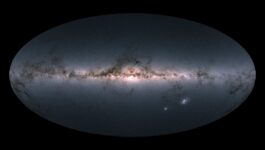
The primordial disk of the Milky Way, PanGu, has been found!
The Milky Way, our galaxy: the bulge is the thicker central region. © ESA, Gaia, DPAC, CC BY-SA 3.0 IGO
Our galaxy, nicely named the Milky Way, has an age commonly estimated at 13.2 billion years out of an age of the Universe estimated at 13.77 billion. It is therefore not the oldest galaxy, but it is part of the first generations.
One of the oldest known stars in the Milky Way is quite logically called the star Methuselah, or HD140283. It is a subgiant, so at the beginning of the end of its life, so to speak, relatively close to us, only 202 light years in the direction of the constellation Libra.
This is the star Methuselah in the constellation Libra. © ESA/Hubble
It is believed to be a population II star, that is, the generation of stars that followed the very first ones lit in the Universe, approximately 13.6 billion years ago. years. Its distinctive feature is that it is extremely poor – deficient – in heavy chemical elements, called “metals” in astrophysics.
PanGu mainly contains extremely old stars, more than 12.5 billion years old!
The “metal” content is therefore one of the main markers of the generation to which the stars belong. And in fact, a team of researchers has just shown that a disk-shaped geometric structure is formed by stars extremely deficient in metals. The authors called this structure PanGu. It contains 2 billion solar masses and stars whose age they estimate to be up to 13.5 billion years!
Graph presenting the distribution of stars in this famous disk according to their age and their Fe/H rate (% of metals, roughly). We see that the majority of them are very old, with a birth certificate greater than 12.5 billion years and up to 13.5 billion. © Maosheng Xiang et al (Nature Astronomy, 2024)
Of course, we are still below the age of the Universe, but that changes a lot of things. First, the existence of this structure would postpone the birth of our Milky Way, because 2 billion solar masses (currently, what's more) implies that this is not a large globular cluster. , but from one of the stellar roots of the Galaxy. Furthermore, it would perhaps force a review of the chronology of the history of the cosmos. Indeed, such old stars in such large numbers, even if they were “only” of population II and not III (the very first), raise questions about the time when the first suns were formed.
Merger of our galaxy with Gaia-Enceladus, a dwarf galaxy, around 10 billion years ago. This new structure would therefore be older than this major event. © Gabriel Perez Díaz, SMM, Instituto de Astrofisica de Canarias
This disk, which can be described as “primordial”, would therefore exist well before the very ancient merger of our galaxy with Gaia-Enceladus, a dwarf galaxy that we absorbed 10 billion years ago. Usually, two major phases of evolution are given to the Milky Way, the first having occurred in the first 5 billion years. But if this structure is confirmed, then there would be an even older major phase and our history would be turned upside down…





